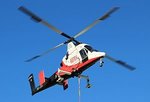GrauGeist
Generalfeldmarschall zur Luftschiff Abteilung
Only because Anton Flettner was hired as chief designer for Kaman...Kaman H-43 and K-MAX are direct decedents of Flettner FI-282 helicopter.
It wasn't a copy, it was a continuation. And it was post-war.
Sikorsky, on the other hand, developed his designs based on his own engineering independent of the helicopters being developed in Germany during the war.

